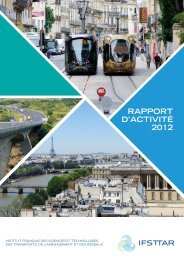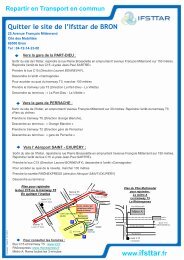french institute of science and technology for transport ... - Ifsttar
french institute of science and technology for transport ... - Ifsttar
french institute of science and technology for transport ... - Ifsttar
You also want an ePaper? Increase the reach of your titles
YUMPU automatically turns print PDFs into web optimized ePapers that Google loves.
esearch orientation 2_<strong>transport</strong> system quality, safety <strong>and</strong> optimization<br />
Modelling driver<br />
behaviours<br />
Moving towards a virtual human<br />
Driving a car is an extremely complex cognitive task <strong>and</strong><br />
IFSTTAR has been working on it <strong>for</strong> several years. The<br />
research focuses on developing a model that is able to<br />
simulate the mental activities <strong>of</strong> a car driver on a computer,<br />
from perception through to action.<br />
From 2008 to the end <strong>of</strong> 2011, in the framework <strong>of</strong> the<br />
European ISI-PADAS (1) project, LESCOT <strong>and</strong> LIVIC have joined<br />
<strong>for</strong>ces to install a version <strong>of</strong> the COSMODRIVE model (2) on the<br />
SIVIC (3) virtual plat<strong>for</strong>m. COSMODRIVE is a cognitive model <strong>of</strong><br />
the driver that is based on a dynamic “perception – decision<br />
– action” regulation loop, that is centred on the driver’s mental<br />
representation. In a way, this representation corresponds to the<br />
driver’s “awareness” <strong>of</strong> the situation.<br />
The scientific <strong>and</strong> technical advances that have been made<br />
during the project mean COSMODRIVE can now drive a car in a<br />
virtual road environment, by using simultaneous synchronized<br />
SIVIC simulations to simulate the external road environment,<br />
the driver’s mental representations <strong>and</strong> some decisions, as<br />
well as the visual strategies <strong>and</strong> driving manoeuvres that are<br />
(1) Integrated Human Modelling <strong>and</strong> Simulation to support Human Error Risk<br />
Analysis <strong>of</strong> Partially Autonomous Driver Assistance Systems.<br />
(2) Cognitive Simulation MOdel <strong>of</strong> the DRIVEr.<br />
(3) Simulation <strong>of</strong> Vehicles, Infrastructure <strong>and</strong> Virtual Sensors.<br />
COSMODRiVE Virtual Driver<br />
COGNiTiON MODULE<br />
Attentional<br />
Processes<br />
(representation<br />
& decision)<br />
Automatic<br />
Processes<br />
(representation<br />
& decision)<br />
“Perception-Cognition-Action”<br />
Regulation Loops<br />
(Attentional versus Automatic)<br />
PERCEPTiON<br />
MODULE<br />
ACTiON<br />
MODULE<br />
Virtual Car<br />
implemented in order to move within the environment <strong>and</strong><br />
interact with other users.<br />
The modelling work has focused on simulating the adverse impacts<br />
<strong>of</strong> the driver being distracted (analysis <strong>of</strong> human error) in<br />
the context <strong>of</strong> potentially critical car following situations based<br />
on experimental data collected from drivers. In connection with<br />
this, one <strong>of</strong> the innovations <strong>of</strong> this research has been to use<br />
the same virtual environment as a mini driving simulator when<br />
collecting this data <strong>and</strong> then as a simulation environment <strong>for</strong><br />
the COSMODRIVE model.<br />
SiViC Virtual Plat<strong>for</strong>m<br />
Virtual Eye<br />
(SiViC Camera)<br />
Perceptive Cycle<br />
3D Model <strong>of</strong> the External<br />
Road Environnement<br />
Virtual Control/Comm<strong>and</strong><br />
Functions<br />
57<br />
Cognitive simulation <strong>of</strong> a driver on<br />
the COSMO-SIVIC plat<strong>for</strong>m.<br />
@ CONTACTS<br />
thierry.bellet@ifsttar.fr & dominique.gruyer@ifsttar.fr<br />
An electric Mini<br />
The drivers’ verdict<br />
IFSTTAR is carrying out the MINI E France study <strong>for</strong><br />
BMW. This sets out to evaluate the level <strong>of</strong> acceptability<br />
<strong>of</strong> electric vehicles (EV) <strong>and</strong> how they modify the driving<br />
behaviours <strong>and</strong> travel practices <strong>of</strong> users.<br />
A panel <strong>of</strong> 47 drivers, in two successive waves, were<br />
given the use <strong>of</strong> an electric MINI <strong>for</strong> a six month period<br />
from December 2010 to June 2011 <strong>and</strong> from July 2011 to<br />
December 2011. Data was collected by means <strong>of</strong> a set <strong>of</strong> questionnaires,<br />
focus groups, travel diaries <strong>and</strong> charging diaries.<br />
The aim was to reveal any changes in behaviours <strong>and</strong> attitudes<br />
during the time the subjects had the use <strong>of</strong> the electric vehicle<br />
(EV), comparing the data at the outset with that collected after<br />
3 months <strong>and</strong> after 6 months.<br />
It emerged that to begin with, the participants’ interest in this<br />
study <strong>and</strong> this type <strong>of</strong> vehicle was conditioned by their sensitivity<br />
to environmental issues <strong>and</strong> their attraction to the <strong>technology</strong>.<br />
It is certain that the limited range, regenerative braking<br />
<strong>and</strong> low noise level <strong>of</strong> this type <strong>of</strong> vehicle modified the users’<br />
daily travel practices <strong>and</strong> behaviour. Some users began to drive<br />
in a way that used less energy, in particular as a result <strong>of</strong> the<br />
regenerative braking. They also chose their routes on the basis<br />
<strong>of</strong> the amount <strong>of</strong> energy they had left <strong>and</strong> favoured other<br />
modes <strong>of</strong> <strong>transport</strong> <strong>for</strong> long trips which are impossible by EV.<br />
Finally, they appear to drive more carefully to compensate <strong>for</strong><br />
the vehicle’s silence, which 50% <strong>of</strong> the participants liked but<br />
saw as potentially dangerous.<br />
Ultimately, it emerged that while most <strong>of</strong> the drivers were happy<br />
with the EV as it is able to satisfy 80% <strong>of</strong> their daily travel needs.<br />
However, its limited range <strong>and</strong> lack <strong>of</strong> room it are very negative<br />
factors which would prevent the MINI E from becoming the<br />
household’s main car.<br />
@ CONTACTS<br />
corinne.brusque@ifsttar.fr & elodie.labeye@ifsttar.fr<br />
The MINI E. (BMW).<br />
annual report 2011 ifsttar.fr






![Trajectoire le magazine n°3 - Juillet 2012 [.pdf] - Ifsttar](https://img.yumpu.com/30038493/1/190x253/trajectoire-le-magazine-na3-juillet-2012-pdf-ifsttar.jpg?quality=85)

